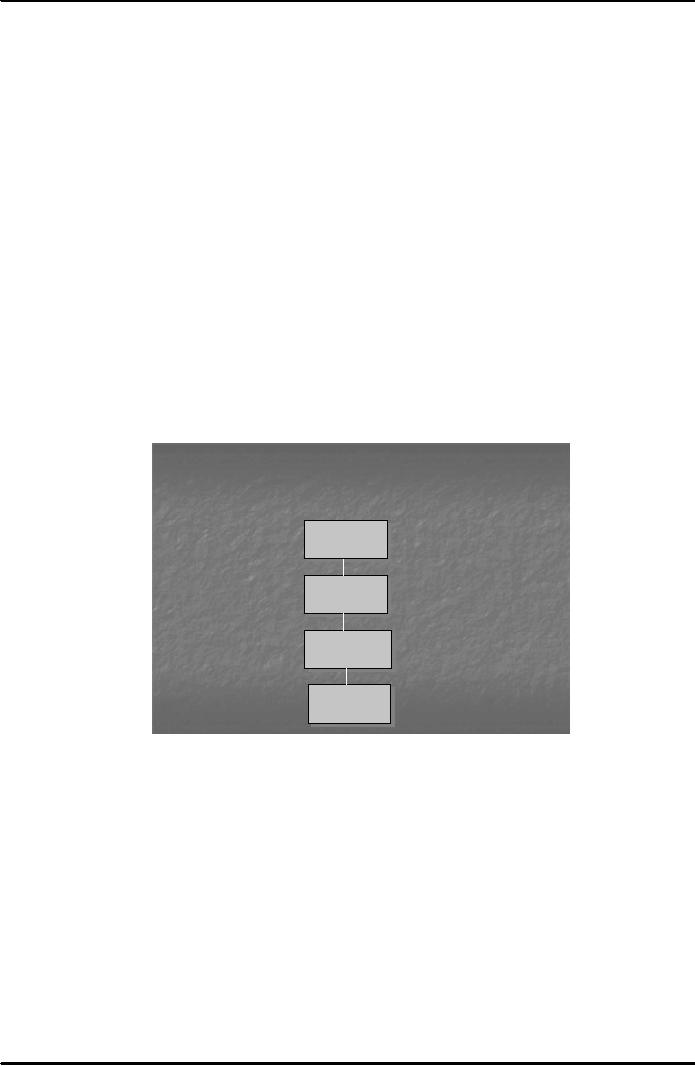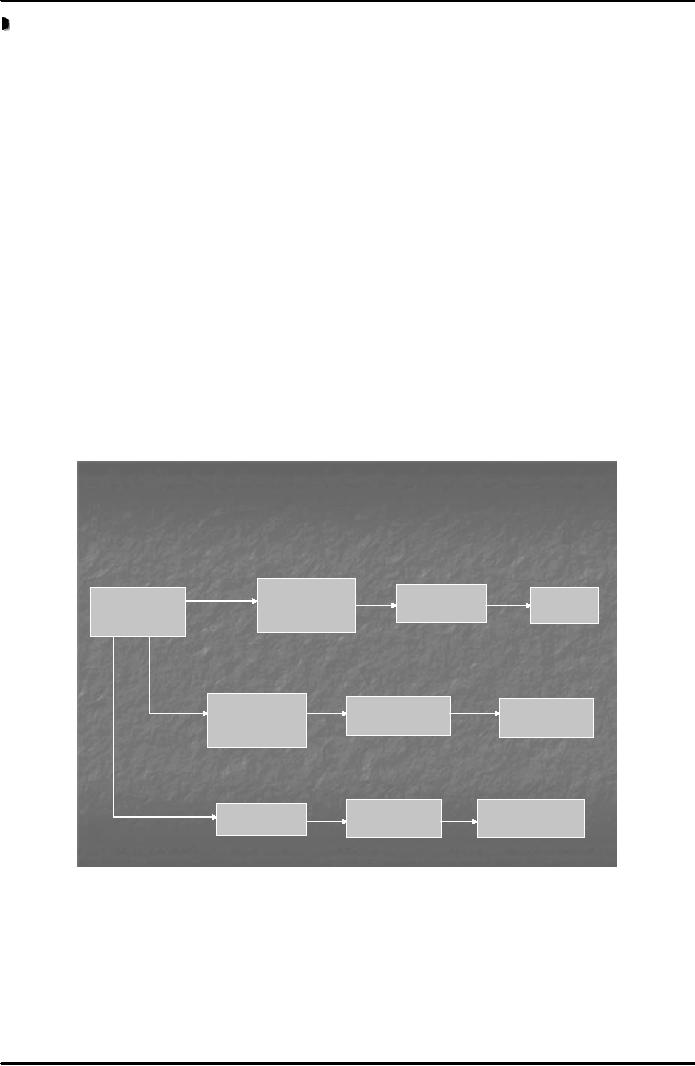 |
GLOBAL LEGAL ISSUES OF E-COMMERCE - 1 |
| << ELECTRONIC TRANSACTIONS ORDINANCE, 2002 - 3 |
| GLOBAL LEGAL ISSUES OF E-COMMERCE - 2 >> |

E-COMMERCE
IT430
VU
Lesson
44
GLOBAL
LEGAL ISSUES OF
E-COMMERCE
The
jurisdiction to try offences under the
ETO is vested with the
session courts in Pakistan. It
may not be
out of
place to mention here about
the hierarchy of courts in Pakistan
(see Fig. 1 below). Law is broadly
divided
into two classes on the
basis of nature of wrong, namely,
civil law and criminal law.
Civil law deals
with
the private rights of the parties,
whereas the object of criminal law is to punish the
wrong-doer. Civil
wrongs
such as breach of contract are
deemed to violate only the rights of
individuals and not the
society in
general.
On the other hand, a criminal wrong
(crime) is an act deemed by
law to be harmful to the society
in
general
such as theft or murder etc.
and the state itself is a party in
such matters.
At the
bottom of hierarchy, the court having
jurisdiction to try civil
wrongs is the civil court
and the one
having
jurisdiction to try crimes is the
court of magistrate. Appeal
against the decision of a civil
court or
magistrate,
in many cases, can be filed
in the District court (in
civil matters) and in the
Session court (in
criminal
matters), respectively. Further, an
appeal can be filed in the
High court, in most cases,
against the
decision
of the district/session court.
Likewise,
the decision of the High court
can be challenged in most
cases before the Supreme Court
of
Pakistan,
which is the apex court (the
court at the top of the hierarchy). It
may be noted that High
Court in
certain
matters has an extraordinary jurisdiction
to entertain cases under Article 199 of
the Constitution of
Pakistan,
which is called the writ
jurisdiction of the High Court.
For instance, where a government
body has
breached
any law, a writ can directly
be filed in the High court
against such a body.
Hierarchy of
Courts
Suprreme
Supeme
Courrt
Cout
High
High
Courrts
Couts
Dissrrcc//Sesson
Di tti i ttSessi
ion
Courrss
Coutt
CivvlilCourrss/
Ci i Coutt /
Courrtsoff
Couts
o
Magissrrates
Magi
ttates
Fig.
1
Most
of the countries have, by now,
made laws providing
recognition to electronic documents
and
electronic
signatures. They have
basically followed a model law on
e-commerce proposed by a U.N.
body
called
UNCITRAL (United Nations
Commission on International Trade Law) in
1996. On analysis, it
appears
that ETO has certain
deficiencies. For instance, difference
between an electronic signature and
an
advanced
electronic signature is not clear.
Sections dealing with the
offences of violation of
informational
privacy
and damage to information/informational
systems are too broadly
worded, which may lead
to
confusion.
International aspects of e-commerce
such as recognition of the foreign
certificates and electronic
signatures
etc. are missing. Difference
in the role of accredited certification
service providers and
non-
accredited
ones has not been logically
defined in the ETO. Above all, the
rules (to be made by the
Federal
Government)
and regulations (to be made
by the Certification Council) under the ETO
are not in place
after so
many years have elapsed
since its
enforcement.
176

E-COMMERCE
IT430
VU
Let us
now examine some major
global legal issues of
e-commerce. They are listed as
follows:
Territorial
jurisdiction
Online
contracts
in cyberspace
Domain
name and trademark
conflicts
Online
defamation
Online
privacy
Issues
of taxation on internet
Cyber
crimes
Territorial
Jurisdiction
There
are different forms of jurisdiction.
Territorial jurisdiction refers to the
competence of a court to
decide
a case on the basis of certain
geographical area/territory. So, if a
dispute arises in Karachi, the
courts
in Karachi
would only have territorial
jurisdiction, and the case cannot be
filed in Islamabad or Lahore.
Ordinarily,
territorial jurisdiction lies
where the defendant resides or carries on
business or the cause of
action
has wholly or partly arisen
or the immoveable property is situated
(in case the matter relates
to land
etc.).
Note
that the person who files a
lawsuit is called plaintiff
and the person against whom
it is filed is called
defendant.
Thus, if a contract is signed at Lahore under
which Mr. Ali has to
deliver certain goods to
Mr.
Imran
at Karachi and Mr. Ali
resides at Rawalpindi, then Mr.
Imran can file a suit
against Mr. Ali for
his
failure
to deliver the goods. This
suit can be filed at any of
the three places, that is,
Lahore, Karachi or
Rawalpindi.
Note
that there is no question of any
conflict of laws in this scenario
since laws all over
Pakistan are almost
the
same. However, things get
complicated when we talk of a
legal dispute in cyberspace
because of the
nature
of the internet which transcends
any geographical boundaries. Here,
different countries, having
different
set of laws, may come
into picture having certain linkage with
the internet transaction. The
issue of
territorial
jurisdiction becomes complicated
when we try to find that the
court of which country has
the
lawful
jurisdiction to decide the internet
dispute.
For
example, an Australian firm having web
site in English doing ecommerce
does not indicate to
its
customers
that it is an Australian firm. The
web server hosting its site
may be located in Canada,
and people
maintaining this
site may be the residents of England.
Assume a Pakistani buys
certain goods from
this
Australian
firm and is, later, unhappy
with the goods received. He
might want to file a lawsuit
against the
Australian
firm. The border/boundary
based system of jurisdiction in the
physical world does not
help this
Pakistani
in determining where to file the case. He
may consider filing the case
in any of the countries
which
have
linkage or connection with the transaction,
namely, Australia, England, Canada or
Pakistan. Another
example
is of a defamatory message sent from
England defaming a Canadian. The
web site may be
hosted
in
Sweden, and the ISP providing
services may be located in Brazil.
Again, four different
countries having
different
set of laws are emerging in
this transaction, that is, England,
Canada, Sweden and
Brazil.
In all
such matters the plaintiff
has an option to choose the
country/forum for filing his
case. Obviously,
the
plaintiff would choose the
forum whose laws are
more favorable to him as compared to the
defendant.
The
relative ease with which the
plaintiff in cyberspace can
drag the defendant to the forum of
the
plaintiff's
choice is called forum shopping.
So, if the law of evidence in
Singapore suits the plaintiff
and he
can
also establish cause of action or linkage
of the internet transaction with
Singapore, then the case may
be
legitimately
filed there. One of the key
tests that the courts have
prescribed to determine
territorial
jurisdiction
in cyberspace is to examine the level of
interactivity, commercial nature
and effects of the
exchange
of information.
177

E-COMMERCE
IT430
VU
Online
contracts
In the
physical world three
elements must be satisfied in
order to make a valid
contract, namely,
offer,
acceptance
and consideration. The same
three elements must also be
present in case of a valid
online
contract.
An offer is a commitment with certain
terms made to another party such as
willingness to buy or
sell
certain product.
A contract is
formed when a party accepts the offer of
another party for consideration. Consideration is
the
agreed
exchange of something valuable
for both the parties such as
money, property or services.
For
example,
Mr. `A' offers to buy a
basket of apples for Rs.
200, which is accepted by
Mr. `B' and thus a
lawful
contract
comes into existence between
them. Here, consideration for Mr.
`A' is the basket of apples he
is
getting,
and for Mr. `B',
Rs. 200 in exchange of his
apples. In most cases when
you click `I accept' or `I
agree'
button on a web page, it
indicates your acceptance to the
terms of a certain offer,
and this can give
rise
to a lawfully binding contract (also
known as a click wrap
agreement).
It is
not necessary to have a
written contract. The contract
can be made orally or by conduct or
through
correspondence.
So, offers and acceptances
can occur in the cyberspace when
parties exchange
email
messages,
engage in EDI, fill out
web forms or download a web
page. An offer can be revoked as
long as
no
payment, delivery of service or other
consideration has been accepted.
Note where a seller
advertises
goods
for sale on a web site, it
is not making an offer but is
inviting offers from potential
buyers.
Normally,
by looking at a web ad, the buyer
can send an order, which in fact is an
offer the seller can
accept,
to form a contract. If the seller cannot
supply the ordered items it has an option
to reject the offer
or
make a counter offer. Then the buyer
has the option to accept or
reject the counter offer
(See
Fig. 2 below to understand
the concept).
Offer and
Acceptance
Unconditional
Valid
Statement
of
Contract
Acceptance
Offer
Acceptance
Conditional
Rejection
of
Becomes
Statement
of
Offer
Counter
Offer
Acceptance
Offer
No
Contract
Rejection
Terminates
Fig.
2
In
online environment acceptances
may be issued by an imposter/cheater that
does not have authority
to
bind
the online business. To overcome this
problem companies and
individuals can use digital
signatures to
establish
identity in online
transactions.
It is particularly
desirable that where a contract is of
significant amount, parties should require each
other
to use
digital signatures to establish
identity and to confirm that
person making an acceptance has
the
authority
to bind the company. Where
due to the failure of a company to
protect the passwords stored
with
it, an
imposter is able to enter company's
system and accept an offer;
a court might find such
negligent
178

E-COMMERCE
IT430
VU
company
to be responsible for the breach of a
contract. In such circumstances the
company may be
directed
to fulfill the terms of the contract or
pay compensation to the aggrieved
party.
in cyberspace
is a huge area of concern in
cyberspace due to the nature of
internet technology. A
is
an
exclusive right granted by
law to the author or creator of a
literary or artistic work to reproduce,
print,
publish
or make copies of such work.
Creations or works that can be
ed include books, music,
artwork,
audio and video recordings, computer
software, architectural drawings,
product packaging
etc.
Note
that there is no in
ideas. Only, a particular form or
expression of the idea can
be
ed. If an
idea cannot be separated from
its expression, the work cannot be
ed. Thus, in
most
cases, mathematical calculations cannot
be ed. Most web pages
are likely to be protected by
because words, graphics and
html tags are arranged in
such a manner that it may
give rise to an
original
work. Naturally, it causes a problem.
Each time an http request is
made by a client, a copy of the
html
document can be made on the client
machine. Similarly, where ISPs
are engaged in caching, an
extra
copy
of the web page is made/stored in cache
memory on the system of the ISP.
Some people had
argued
that
law could not be enforced on
the internet in the above
circumstances.
There is a
concept of `fair use' or `fair dealing' in
law that provides legitimate
exceptions to
violation. Generally, fair use of a
ed work includes copying it for
use in criticism,
comment,
news reporting, teaching,
scholarship or research. Experts draw
support from this concept of
`fair
use' to deal with the
problem of over the
internet. It is also argued
that in cases where
the
author
of a work has himself provided a
hyperlink leading to his
work, he should be regarded as giving
the
implied
authority or license to download or
make copies of his work. In
such an eventuality, the issue of
should not arise according to an
opinion.
Generally,
the protection under `fair
use' may be sought on the
following basis:
Nature
of use:- the work has been
used for educational and/or
non-profit purposes
only;
Nature
of work:- if the copied work contains
factual information then it
may be more effectively
covered
under the
fair use clause as opposed
to some creative
work;
Extent
of the work copied:-
if
the amount of work copied is insignificantly
small then the courts might
take
a view
favorable to the accused;
Effect
on the market value of the work:- A
person alleged with the
violation may
escape any
liability
arguing that the work has
not been circulated to many
people and there has not
been any negative
impact
on the value of actual work
due to the circulation.
When
you make fair use of a
ed work you should provide
citation to the original work to
avoid
any
charge of plagiarism. The
charge of plagiarism can be
leveled against a person who
tries to copy the
expression
of the original author presenting it be
his expression in order to
obtain credit for the
academic
work.
Academic institutions can
take serious action against
students/persons who are
found guilty of
plagiarism.
It may
be interesting to refer to the famous `Napster
case', here. The company,
Napster, had a web site.
It
used
to provide software and a
network to millions of people using
which they could exchange music
files
on
internet that they had copied
and compressed into MP3
format. Many music recording
companies sued
Napster
for facilitating violations of
their . Napster argued
that it only provided the
way or
machinery
but was not directly
involved in violation.
Disagreeing with that the
courts in America
found
that Napster was guilty of
vicarious or contributory
infringement, as it was capable
of
supervising
infringing activity and was
obtaining a financial benefit
for such an activity.
Eventually, the
court
ordered that Napster site should be shut
down. Napster agreed to pay 26
million dollars in damages
for
infringement to a group of
music companies and agreed
to pay holders for
the
music
that would be downloaded in
future.
179

E-COMMERCE
IT430
VU
World
Intellectual Property Organization (WIPO) is a
U.N. sponsored body. In 1996
it proposed two
international
treaties on which
were signed by many
countries of the world. Those
who signed
these
treaties agreed to adopt or
amend laws in their
respective countries to ensure
protection to
ed
work of the author of a signatory
country in view of the new infrastructure
or technological
developments
in respect of digital information
exchange.
180
Table of Contents:
- E-COMMERCE
- WHAT IS A NETWORK
- HOW MANY CLASS A, B, C NETWORKS AND HOSTS ARE POSSIBLE
- NETWORKING DEVICES
- BASICS OF HTML 1
- BASICS OF HTML 2
- TEXT BOXES, CHECK BOXES, RADIO BUTTONS
- FRAMES AND IMAGES IN HTML
- TAG ATTRIBUTES, SOUNDS FILES, ANIMATIONS
- STYLE SHEETS 1
- STYLE SHEETS 2
- SOME USEFUL STYLE SHEETS PROPERTIES
- JAVA SCRIPTING 1
- JAVA SCRIPTING 2
- JAVA SCRIPTING 3
- JAVA SCRIPTING AND XML
- CLIENT AND SERVER SIDE PROCESSING OF DATA
- APPLETS, CGI SCRIPTS
- MAINTAINING STATE IN A STATELESS SYSTEM
- INTEGRATION WITH ERP SYSTEMS
- FIREWALLS
- CRYPTOGRAPHY
- HASH FUNCTION AND MESSAGE DIGEST
- SYMMETRIC KEY ALGORITHMS
- VIRTUAL PIN PAYMENT SYSTEM
- E-CASH PAYMENT SYSTEM 1
- E-CASH PAYMENT SYSTEM 2
- SECURE SOCKET LAYER (SSL)
- E-BUSINESS: DISADVANTAGES OF E-BUSINESS
- E-BUSINESS REVENUE MODELS
- E-MAIL MARKETING
- CUSTOMER RELATIONSHIP MANAGEMENT (CRM)
- META INFORMATION
- DATA MINING
- CONFIDENCE AND SUPPORT
- ELECTRONIC DATA INTERCHANGE (EDI)
- PERSONAL FINANCE ONLINE
- SUPPLY CHAIN
- PORTER’S MODEL OF COMPETITIVE RIVALRY
- BARRIERS TO INTERNATIONAL E-COMMERCE
- ELECTRONIC TRANSACTIONS ORDINANCE, 2002 - 1
- ELECTRONIC TRANSACTIONS ORDINANCE, 2002 - 2
- ELECTRONIC TRANSACTIONS ORDINANCE, 2002 - 3
- GLOBAL LEGAL ISSUES OF E-COMMERCE - 1
- GLOBAL LEGAL ISSUES OF E-COMMERCE - 2